On a recent visit to London, we had just enough down time to visit a house museum near Mayfair that came highly recommended. The Wallace Collection has been open to the public as a museum for over 100 years, and it’s a wonderful experience. Here’s a photo journal of the beauty and grace we saw and felt at The Wallace Collection in London.
We love house museums because they tend to be far more intimate, quirky and lovely than their far larger cousins, the major institutional art and culture museums.
Among our favorites? The Isabella Stewart Gardner Museum in Boston. The Neue Gallerie in Manhattan. The Musée Jacquemart-André in Paris. Spencer House in London.
Now we now have another wonderful house museum to add to our list for London: The Wallace Collection. Our friends at The Beaumont Hotel in Mayfair suggested that we pay a visit. We admit, we had never heard of it before. This is why it helps to have a great concierge to send you in the right direction!
Having made the trip, we’re adding this our list of authentic and enjoyable experiences on our Two Hours in London list. You can easily squeeze in a visit if you have even an hour free to explore the city on your next business trip. And if you’re not in a hurry? Even better.

The Wallace Collection London. Photo Credit: Dandelion Chandelier.
Basic information about the Wallace Collection in London
what is the wallace collection?
The Wallace Collection is a national museum that displays works of art collected in the 18th and 19th centuries by the first four Marquesses of Hertford and Sir Richard Wallace, the son of the 4th Marquess. The collection was bequeathed to the British nation by Sir Richard’s widow, Lady Wallace, in 1897. It was opened to the public as a museum in 1900.
where is it?
Works are on view at Hertford House, one of the family’s London properties in the nineteenth century. It’s in Marylebone, a short stroll from Mayfair and High Street shopping. Making it really easy to get to while you’re on foot and exploring London.
how much does it cost to visit?
Like so many wonderful experiences in London, a visit to the Wallace Collection is free. If you like, and if you’re able, you can make a suggested donation of £5 – or purchase a museum guide for £10. But there’s no mandatory entry fee. So come on in!
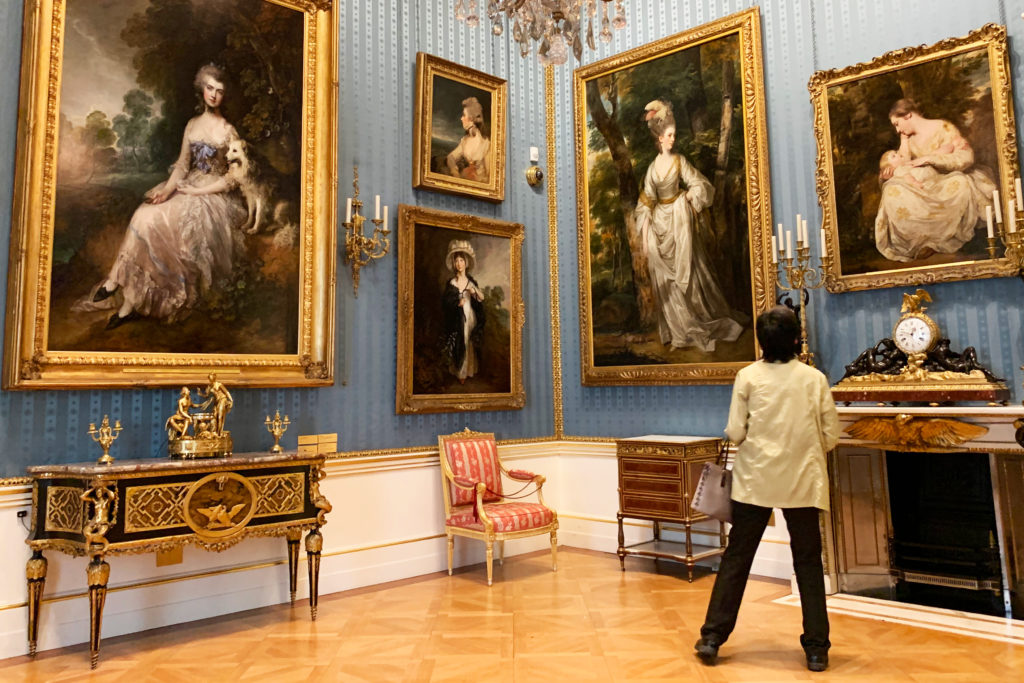
The Wallace Collection Museum in London. Photo Credit: Dandelion Chandelier.
10 must-see highlights on a visit to the wallace collection in London
There are lots of treasures to discover on a visit to the Wallace Collection. Here are 10 stops that we’d recommend, based on our first visit.
1. A Grand Entrance
The best way to approach The Wallace Collection, to understand its grandeur and also its place in a prime part of London, is to walk over on Duke Street.
exterior views
As you approach, you’ll be able to spy it through the gates of Manchester Square, a private gated garden.
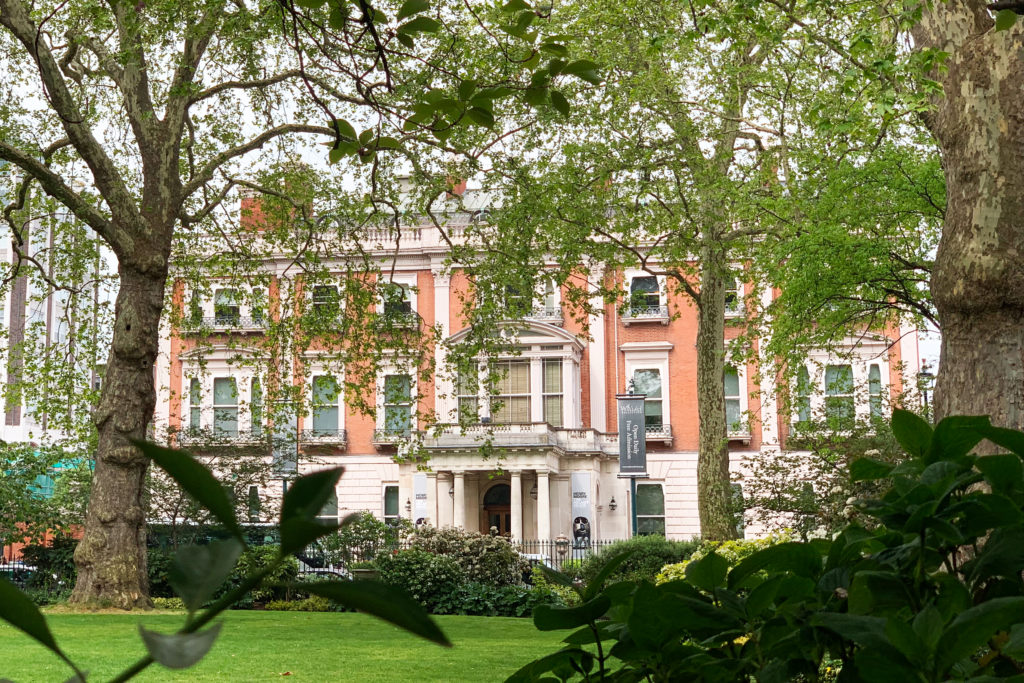
Exterior view of the Wallace Collection museum in London. Photo Credit: Dandelion Chandelier.
If the weather is fine, the front lawn of the museum will be occupied by students, neighborhood residents and visitors sunning themselves and having a bite to eat.
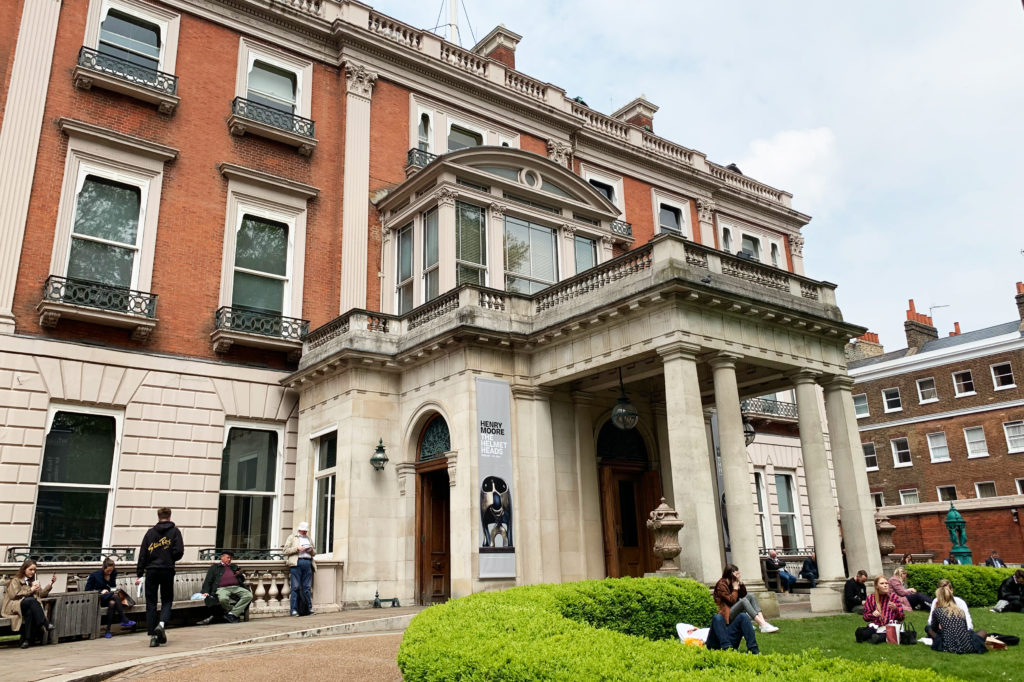
Front lawn of the Wallace Collection Museum in London. Exterior view of the Wallace Collection museum in London. Photo Credit: Dandelion Chandelier.
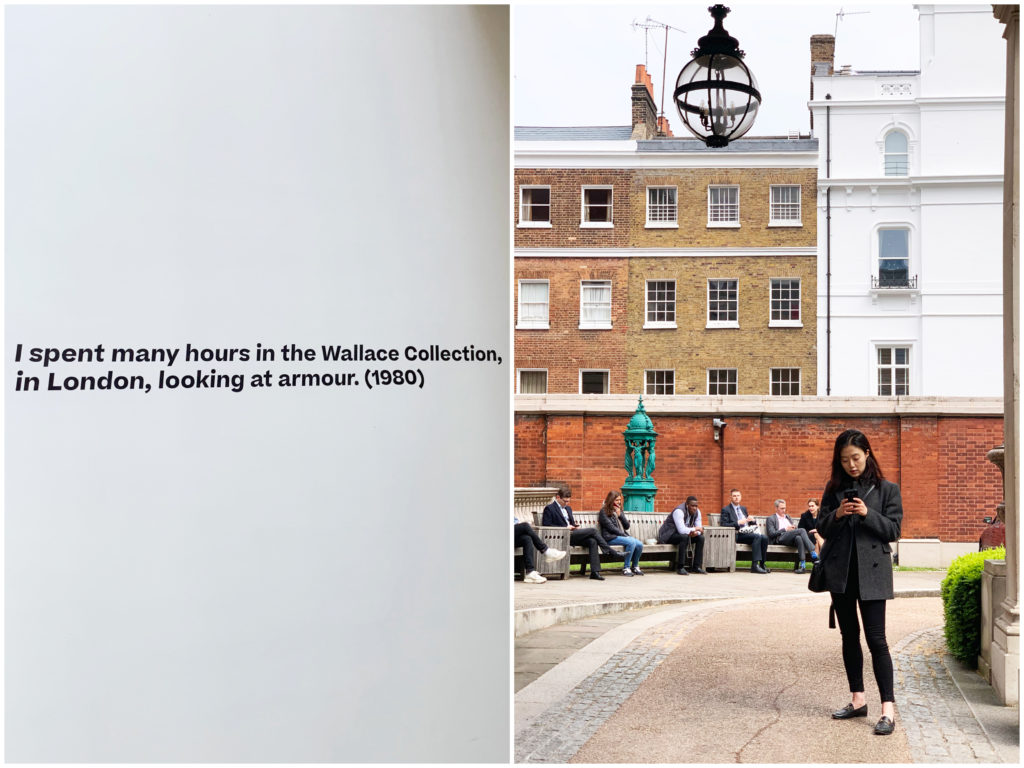
Entrance to The Wallace Collection in London. Photo Credit: Dandelion Chandelier.
the entry foyer
Upon entry, you’ll find yourself at the foot of a grand staircase with art on either side. It’s made of wrought iron, cast iron, gilt brass, and wood. And it’s magnificent.
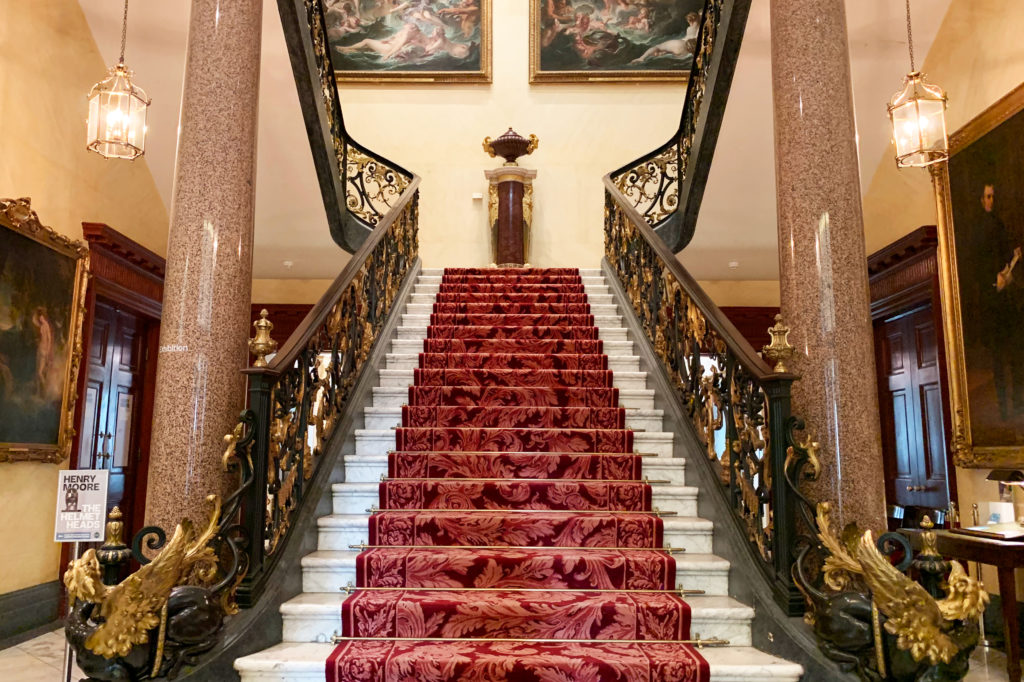
The Grand Staircase at the Wallace Collection Museum in London. Photo Credit: Dandelion Chandelier.
Your first major decision is whether to start by exploring the entry level, or succumbing to the lure of the stairs.
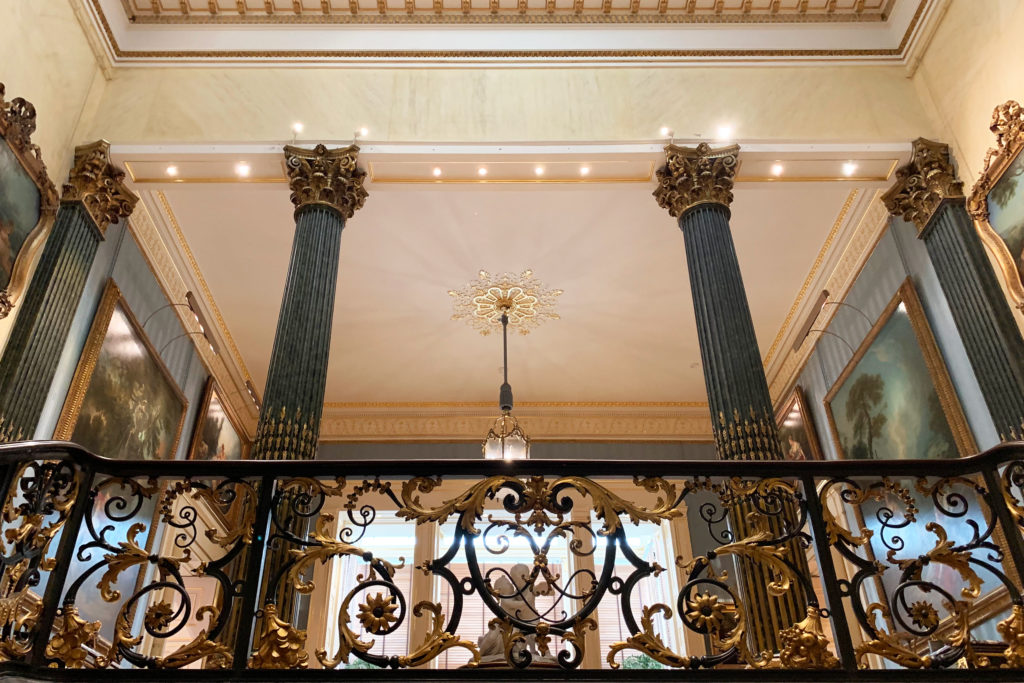
Interior View of the Wallace Collection Museum in London. Photo Credit: Dandelion Chandelier.
Don’t know about you, but we immediately by-passed everything on the ground floor, and started up the stairs. Seriously, how could you not want to see what’s up there? The good news, dear reader, is that it’s even better than you might have expected.
2. Miniature Treasures
All throughout the house, in almost every gallery, there are small gems waiting to be seen by observant eyes. Dazzlingly ornate ceramic pill boxes. Candlesticks. Urns.
We noticed the incredible craftsmanship and attention to detail in even the smallest elements, like the eagles carved into the balustrade of the grand staircase.

Photo Credit: Dandelion Chandelier
On the Landing we spotted these beautiful small vases, from an unattributed source, crafted circa 1765 in France.
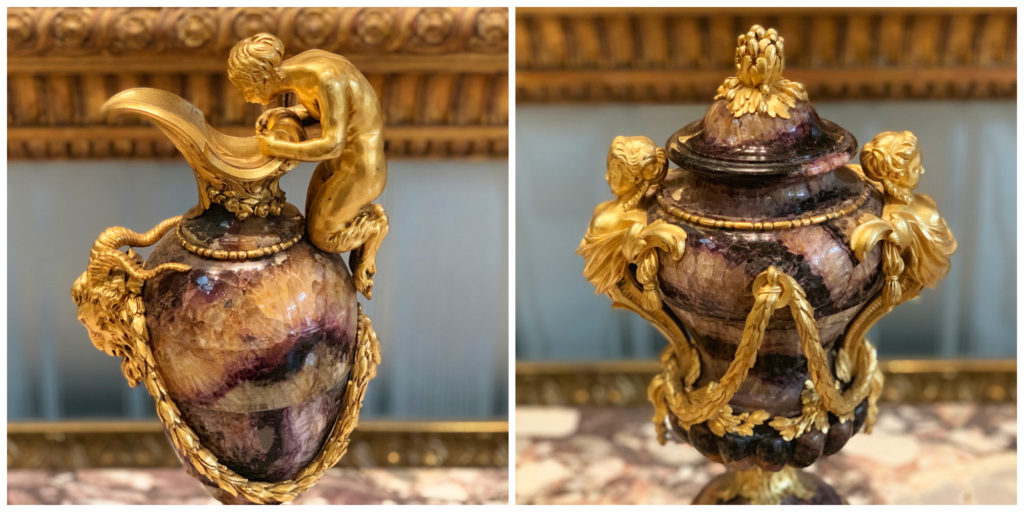
Vases at The Wallace Collection. Photo Credit: Dandelion Chandelier.
Throughout, there are urns, candlesticks, boxes, vases and clocks that demonstrate incredible craftsmanship. Some of the most dazzling objects at the Wallace Collection are the smallest ones.
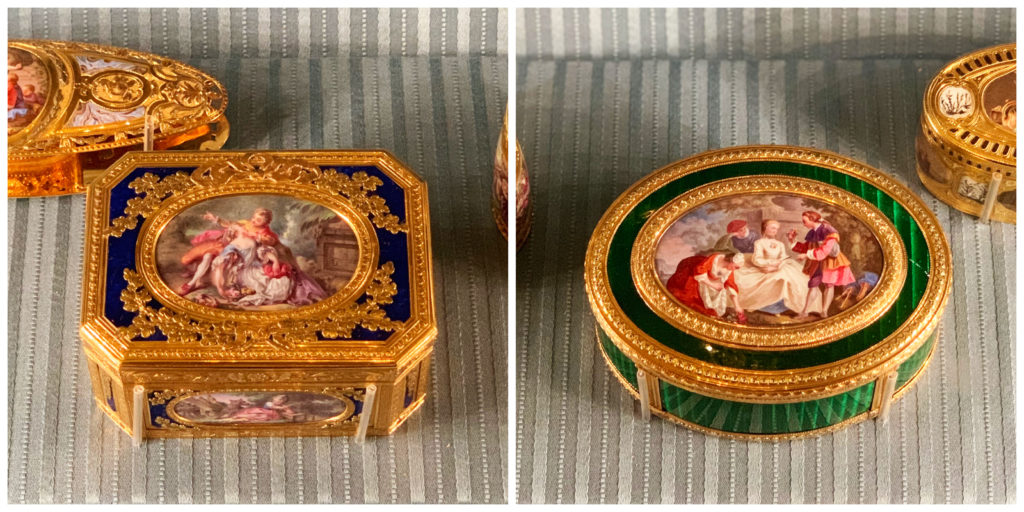
Decorative art at the Wallace Collection in London. Photo Credit: Dandelion Chandelier.
3. The Swing
One of the most special and evocative paintings in the Wallace Collection is by Jean-Honoré Fragonard. In the charming Oval Drawing Room, you’ll find Les hasards heureux de l’escarpolette (The Swing), a classic example of 18th-century French art.

Paintings at the Wallace Collection museum in London. Photo Credit: Dandelion Chandelier.
The story the painting tells is one of romantic mischief. As the museum’s catalog explains, “A young woman wearing a pink silk frock is positioned mid-air on a swing between her elderly husband on the right and her young lover on the left. The force of the swing has caused one of her slippers to fly off, resulting in a privileged view for her lover, whose delight is suggested by the symbolic offer of his hat.”
This room also holds dreamy paintings from François Boucher and furniture from Jean-Baptiste Boulard. The mantle holds the famous golden Avignon Clock crafted by Pierre Gouthière.
4. The Study
The Study is one of our favorite rooms, in no small part because of all of the portraits of women. Many of the female subjects in these paintings convey intelligence and confidence (and they’re fully clothed!) We weren’t all that surprised to learn that two of them were painted by a female artist from France, Élisabeth-Louise Vigée Le Brun (1755 – 1842).
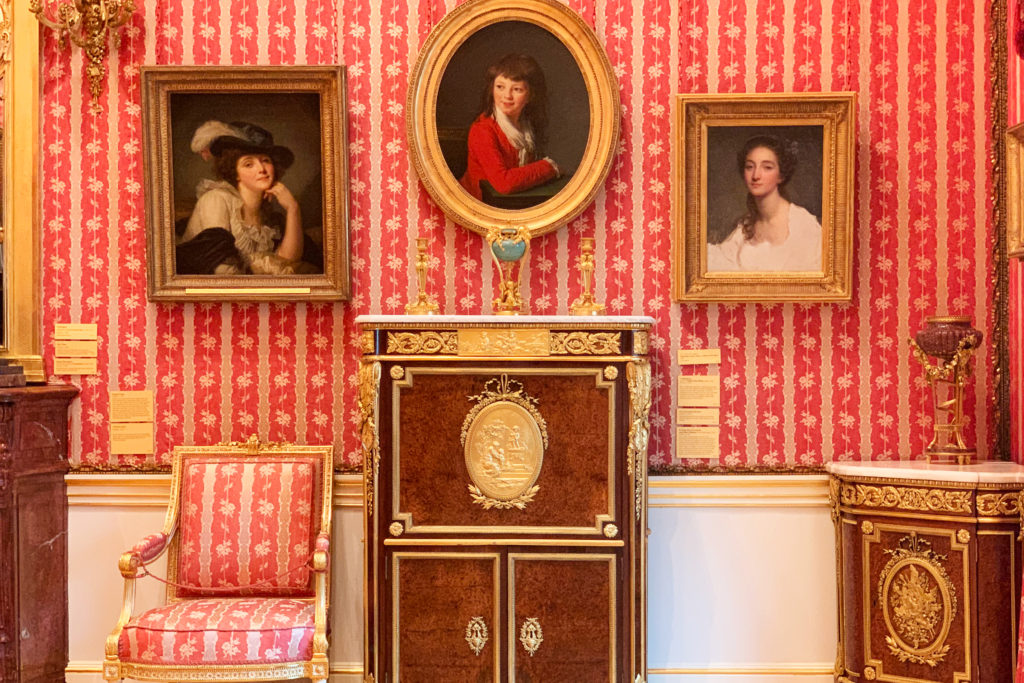
The center portrait is by French painter Élisabeth-Louise Vigée Le Brun. The Wallace Collection in London. Photo Credit: Dandelion Chandelier.
Among the wonderful decorative art objects at the museum are eleven pieces of wooden furniture attributed to the German furniture maker Jean-Henri Riesener. Many of them are from the private apartments of Queen Marie-Antoinette.
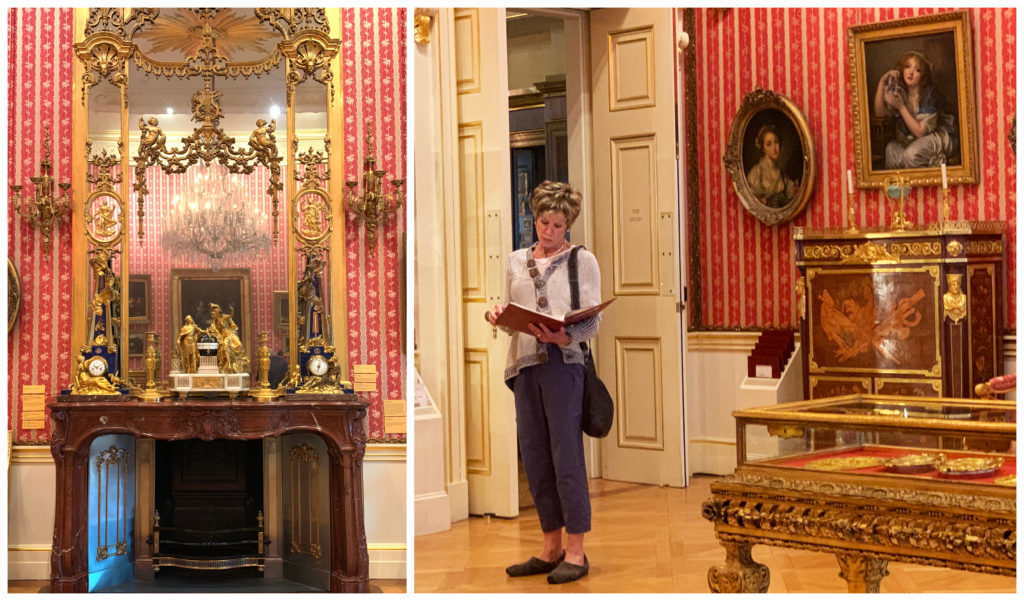
Paintings at The Wallace Collection in London. Photo Credit: Dandelion Chandelier.
5. The Large Drawing Room
A luscious shade of deep emerald green marks the Large Drawing Room. As bibliophiles, we swooned over the stately bookcase – The Londonderry Cabinet – crafted by French furniture-maker Etienne Levasseur.
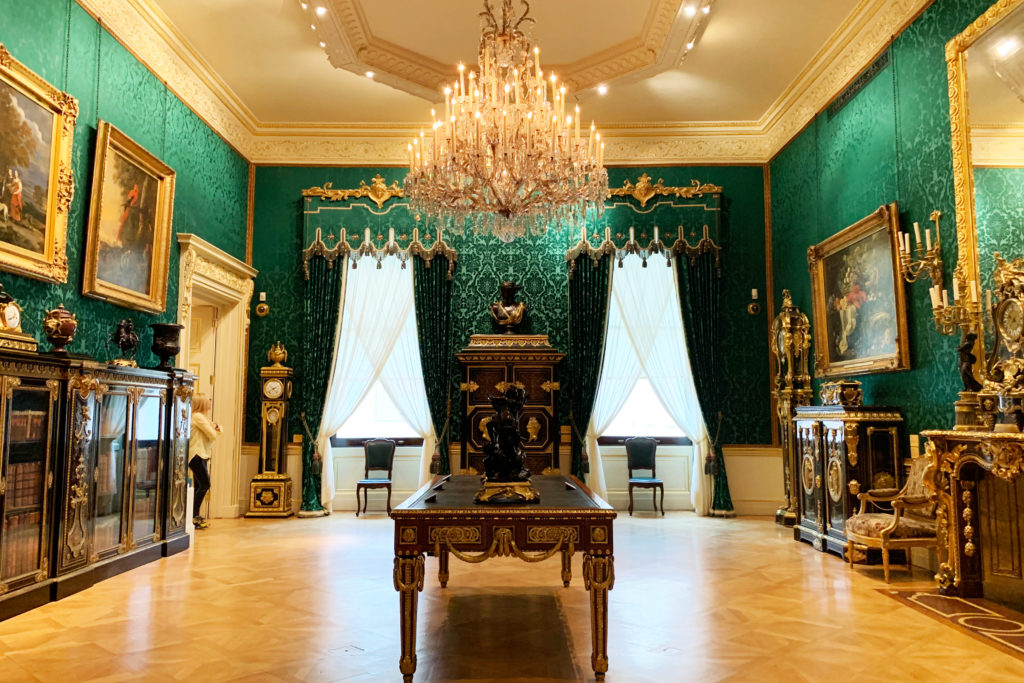
Large Drawing Room at The Wallace Collection in London. Photo Credit: Dandelion Chandelier.
This gallery is filled with mostly decorative arts, such as this unattributed marble bust of Louis XIV, King of France. The paintings are still-lives from various Dutch artists.
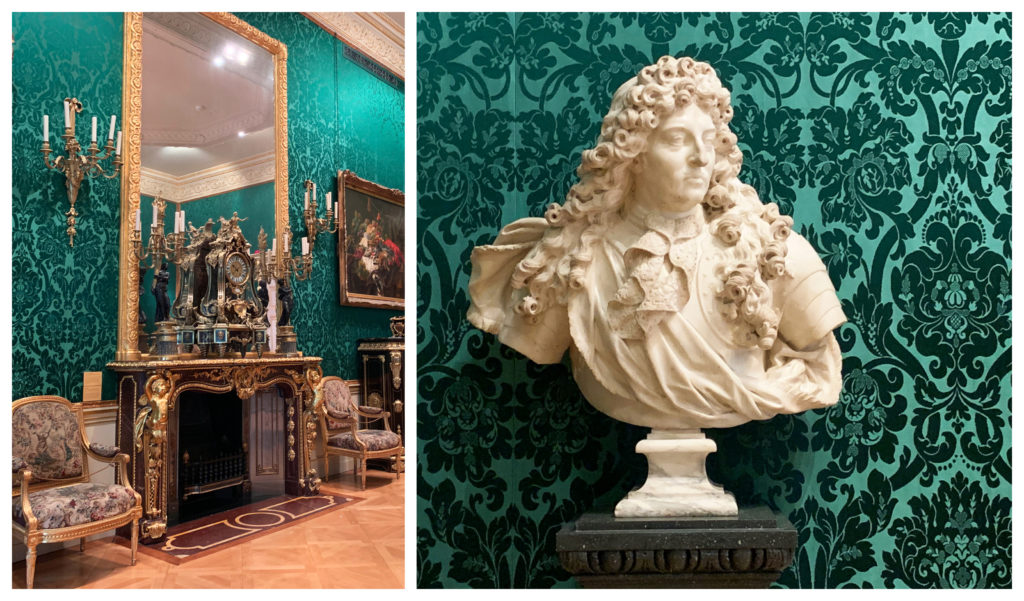
A gallery at the Wallace Collection museum in London. Photo Credit: Dandelion Chandelier.
6. The East Galleries
The various East Galleries are a must-stop if you love paintings. The walls are filled with landscapes and portraits, including a notable work by Rembrandt, Titus, the Artist’s Son.
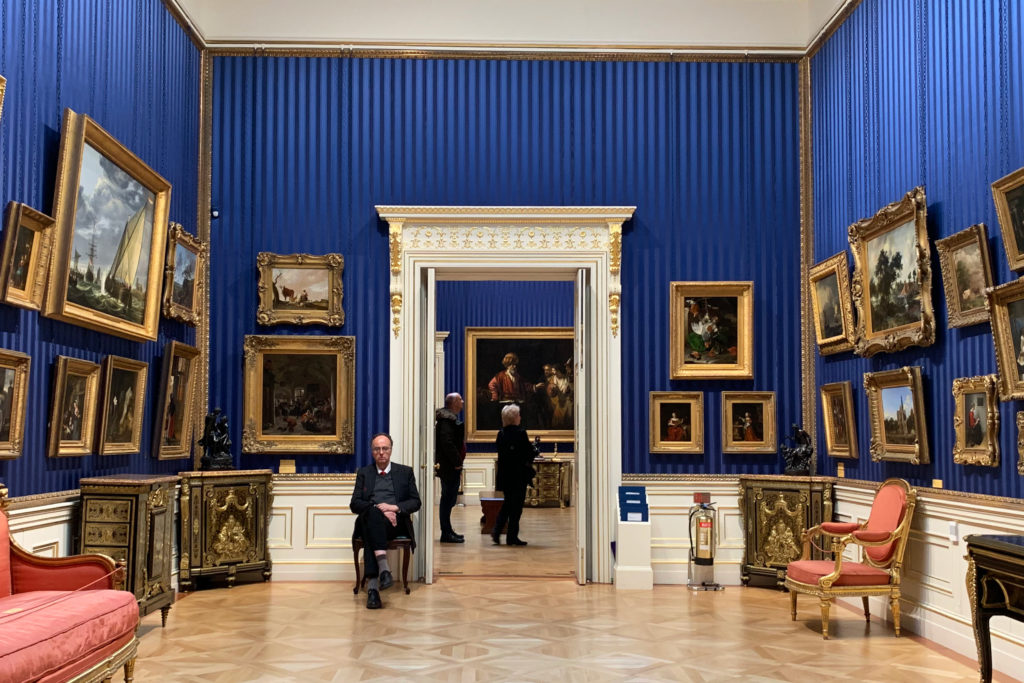
East Gallery at the Wallace Collection in London. Photo Credit: Dandelion Chandelier.
In the East Gallery II, there are both bucolic, pastoral landscapes and seascapes filled with merchant sailing ships. Interestingly, there are almost no scenes of war and conflict in these works.
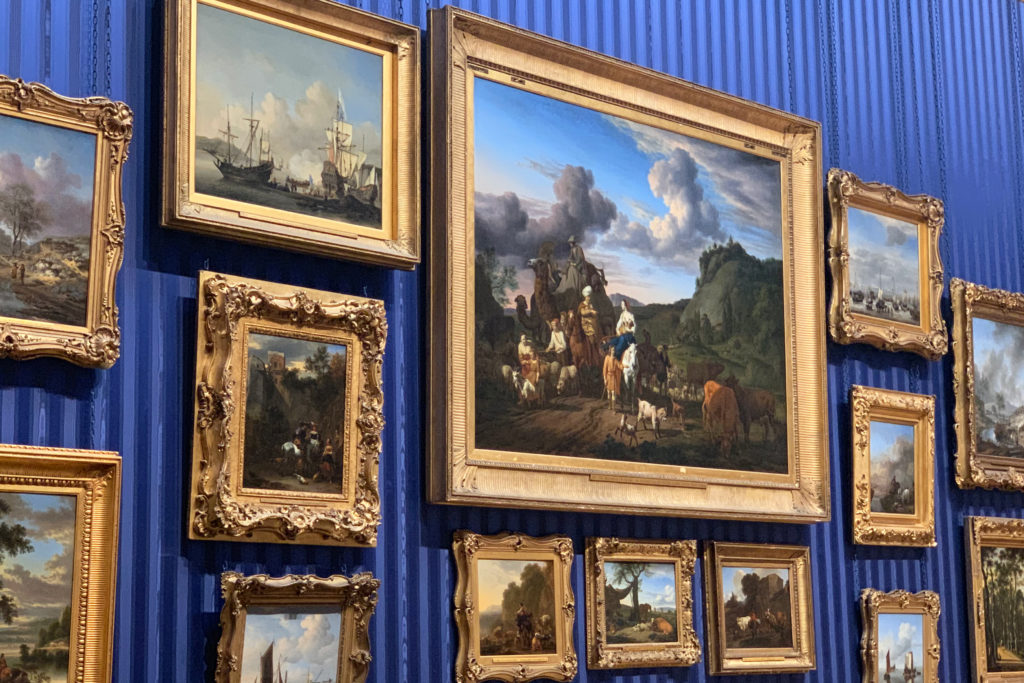
An East Gallery inside the Wallace Collection in London. Photo Credit: Dandelion Chandelier.
Rather, these are scenes of everyday life. Some of our favorite paintings from the East Galleries, which are filled with works from the Netherlands, include the warm domestic scene in Pieter de Hooch‘s A Woman peeling Apples. Landscape with Cattle, which is attributed to Dutch painter Jan Wijnants. Govaert Flinck‘s A Young Archer (who bears an uncanny resemblance to one of our sons). And The Centurion Cornelius, attributed to a follower of Rembrandt.
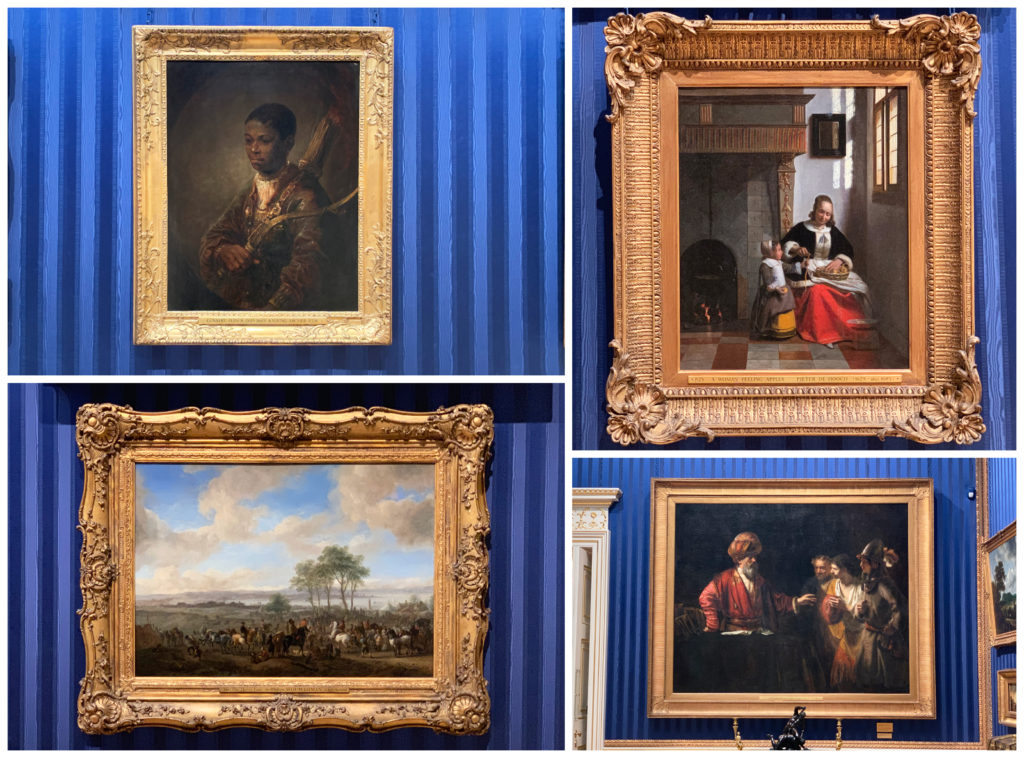
Selected paintings from the East Galleries of The Wallace Collection in London. Photo Credit: Dandelion Chandelier.
Perhaps the aggression not seen in these works was left to be channeled by the family’s notable collection of arms and armor, which resides in a different part of the museum.
7. The “Venice Room”
West Gallery I can best be described as “the Venice Room.” It’s filled with landscapes of the canals and iconic structures of Venice. In addition to works by Canaletto, there are paintings of the city by Francesco Guardi, sculptures from Italian artist Massimiliano Soldani Benzi, and a Venetian chair.
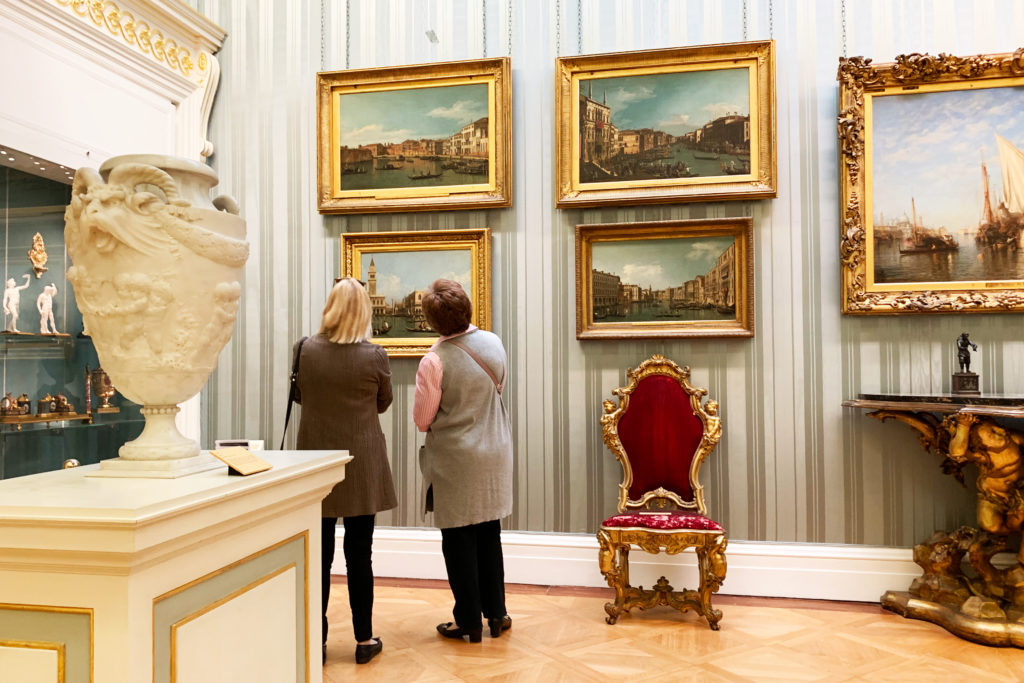
Paintings in a gallery at the Wallace Collection Museum in London. Photo Credit: Dandelion Chandelier.
8. The Great Gallery
The upper-level Great Gallery holds a number of paintings with both sacred and secular themes. One of the most spectacular is The Rainbow Landscape, a magnificent work by Peter Paul Rubens, the great Flemish painter of the Baroque era.
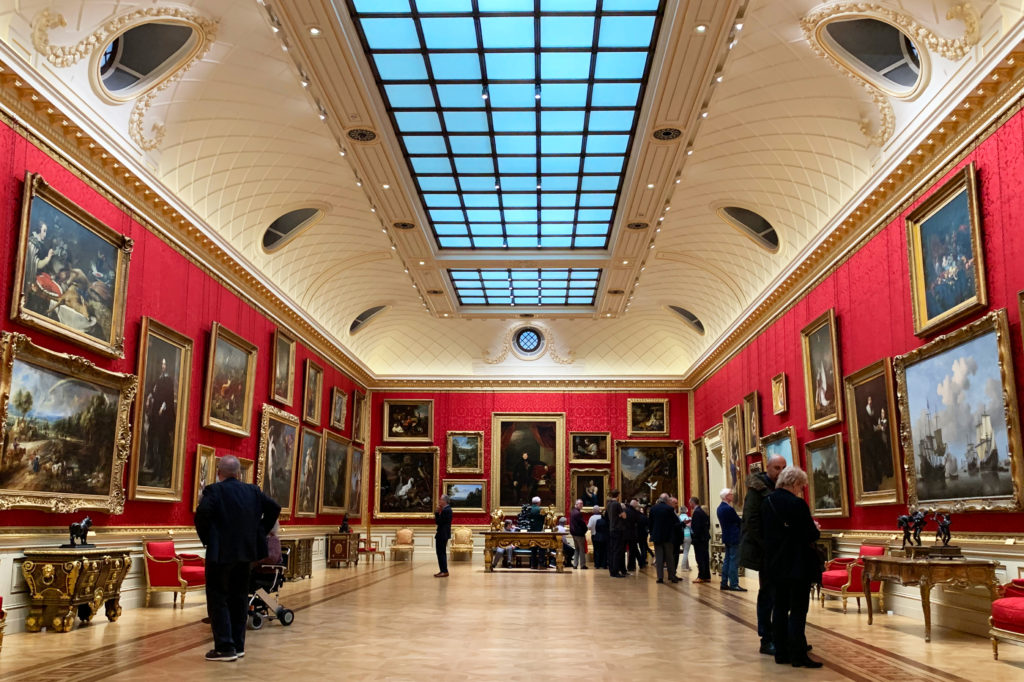
Paintings at The Wallace Collection in London. Photo Credit: Dandelion Chandelier.
Here, you’ll also find The Lady with a Fan by Diego Velázquez, who was King Philip IV of Spain’s favorite court painter. And Venice: the Bacino di San Marco from the Canale della Giudecca, one of Canaletto’s finest paintings.
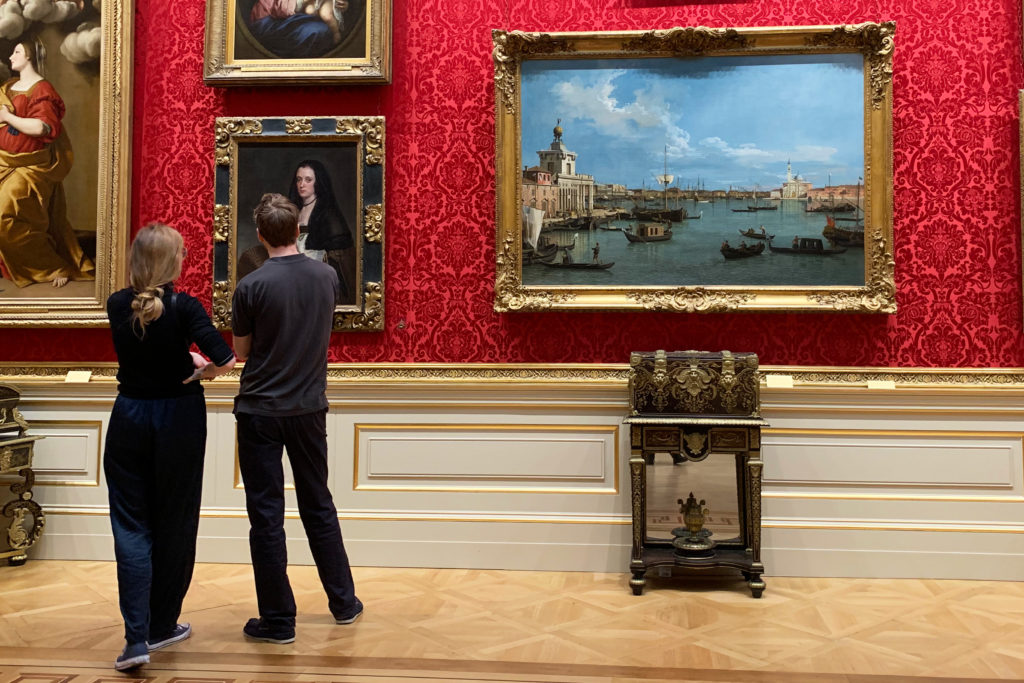
Velázquez’s The Lady with a Fan at the Wallace Collection Museum in London. Photo Credit: Dandelion Chandelier.
The Adoration of the Shepherds, painted by Philippe de Champaigne, provides a blaze of deep blue against the rich red walls of the gallery.
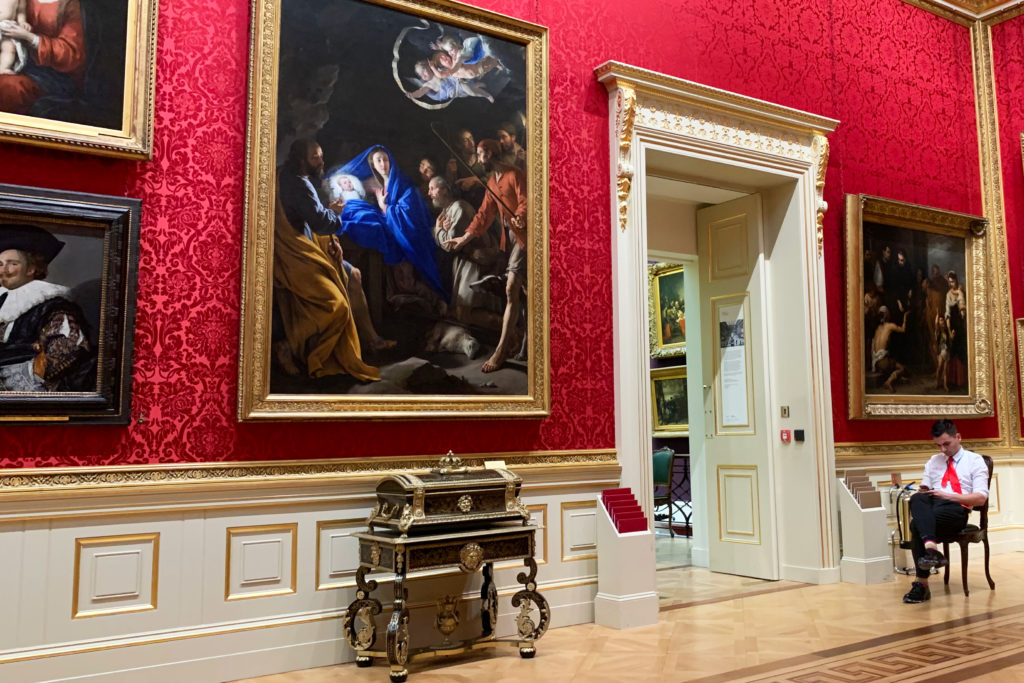
The Great Gallery at The Wallace Collection in London. Photo Credit: Dandelion Chandelier.
A wonderful group of Dutch paintings are clustered at the far end of the Great Gallery. We love Peacocks and Ducks by Melchior d’Hondecoeter (although the graceful white dove is clearly stealing the show). The blue of the robe worn by the subject in Anthony van Dyck‘s portrait is just stunning.
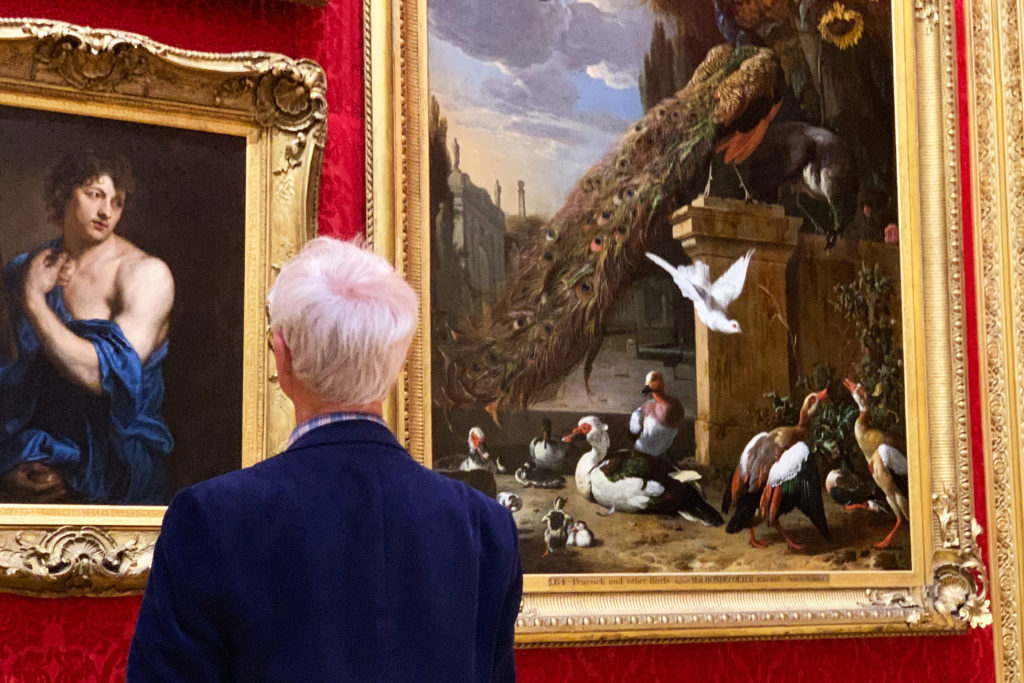
A visitor at the Wallace Collection Museum in London. Photo Credit: Dandelion Chandelier.
We also found this portrait of an unnamed woman hard to walk away from – something about her expression and the richness of her attire resonated with us.
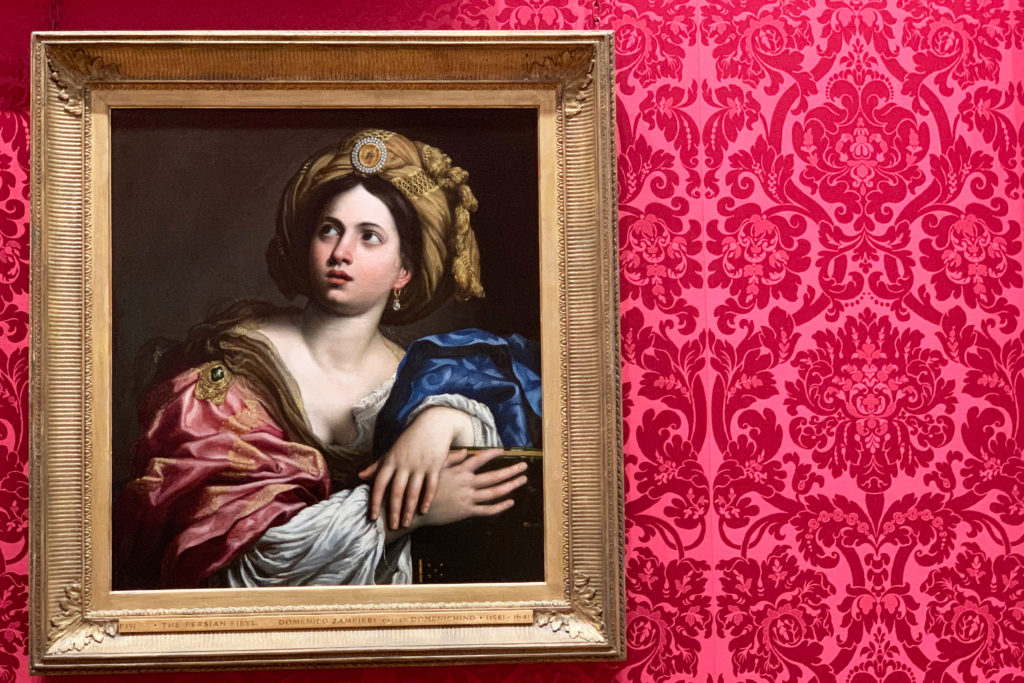
A Sybl, a painting by Domenichino made in the early 1620’s, at The Wallace Collection in London. Photo Credit: Dandelion Chandelier.
9. The West Gallery
Another dramatic and gorgeous space is the West Gallery, which emits natural light through the roof and includes portraits and small sculptures.
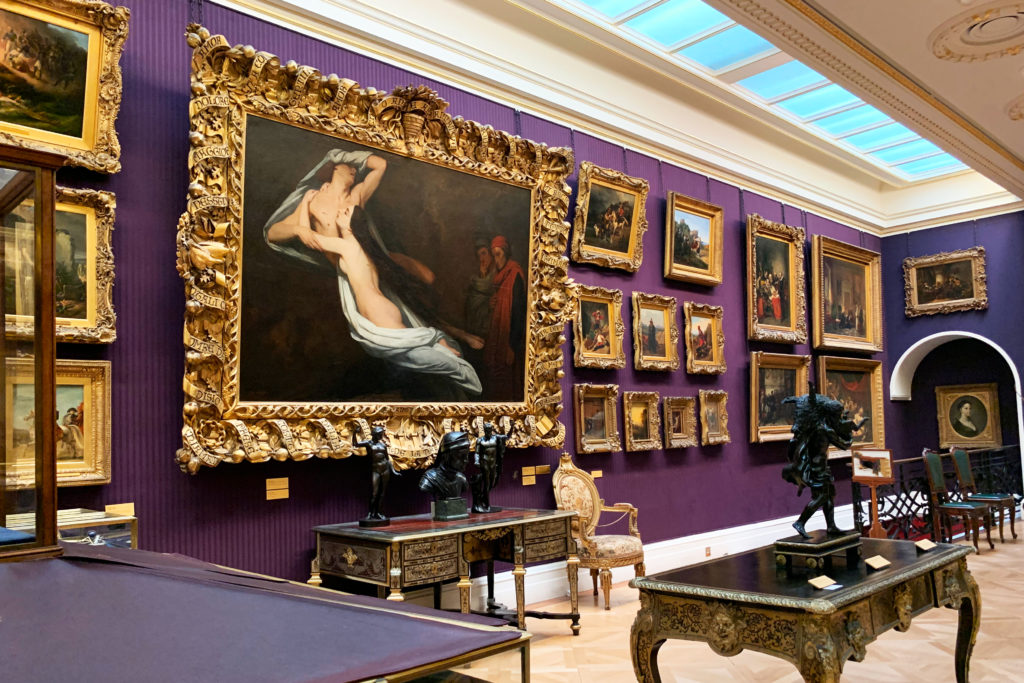
Paintings at The Wallace Collection in London. Photo Credit: Dandelion Chandelier.
Among the paintings that caught our eye here are David Roberts’ Lierre: Interior of Saint-Gommaire and – continuing the love of La Serenissima that is a through-line in this collection – Richard Parkes Bonington’s Venice: the Piazza San Marco.
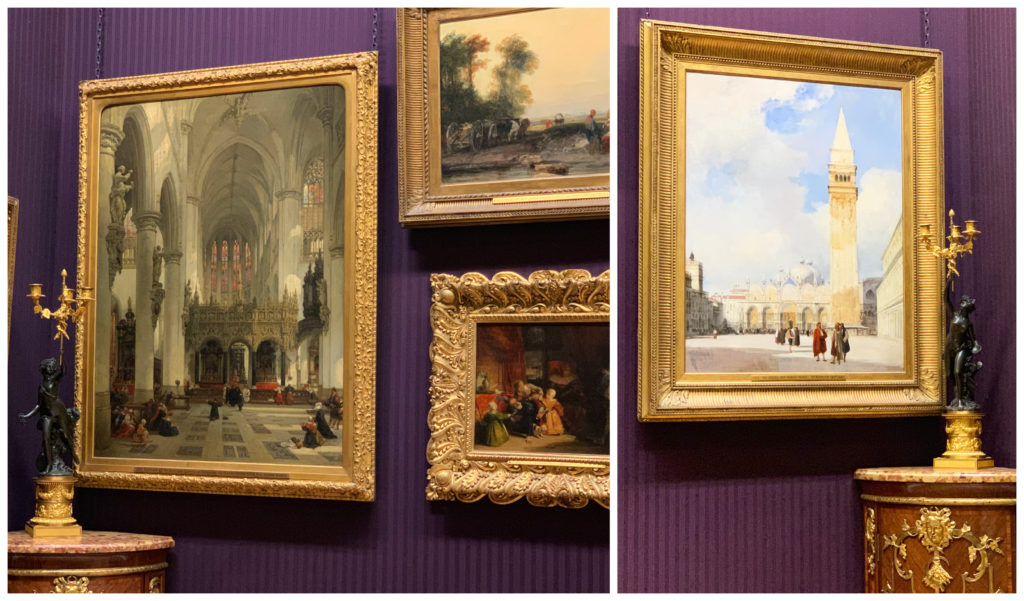
Paintings at the Wallace Collection Museum in London. Photo Credit: Dandelion Chandelier.
10. The State Rooms
Having roamed through the entirety of the first floor, we finally turned our attention to the galleries and exhibits on the ground floor. The two State Rooms are not-to-be-missed. But be sure to take this gorgeous staircase, rather than the main one, on your way down. There are lovely jars, urns, ceramics and other decorative items to see on the way.

The Wallace Collection. Photo Credit: Dandelion Chandelier.
The Front State Room is a glorious space that is home to portraits of many of the family members who contributed to The Wallace Collection. It also proudly displays a large oil portrait of Queen Victoria painted by Thomas Sully. It’s paired with John Hoppner‘s painting of George IV as Prince of Wales.
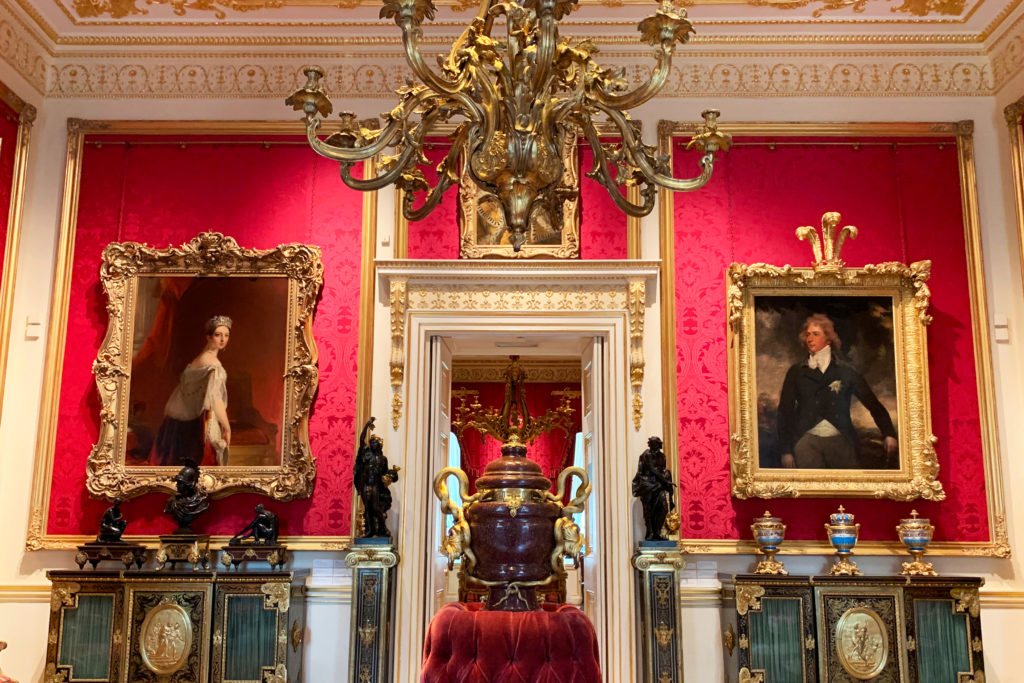
Front State Room at The Wallace Collection in London. Photo Credit: Dandelion Chandelier.
The Back State Room is presided over by an enormous chandelier crafted by French artist Jacques Caffieri. Many of the paintings here are hunting scenes and still-lives from a fellow Frenchman, Jean-Baptiste Oudry.
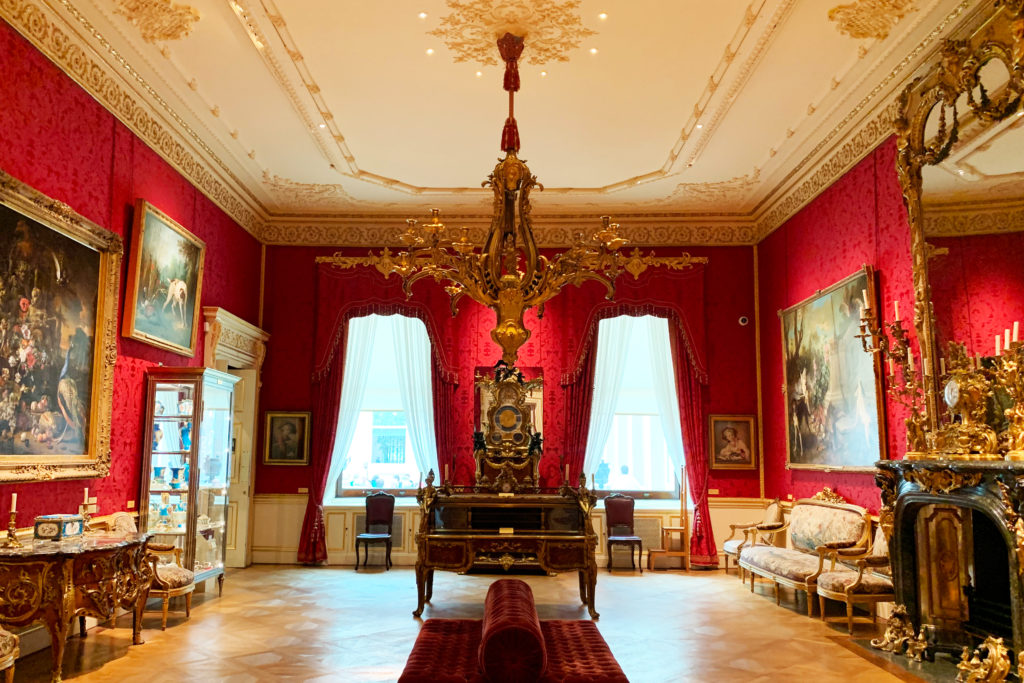
The Back State Room at The Wallace Collection in London. Photo Credit: Dandelion Chandelier.
The ground floor is also home to the European Armory collection, which is spread throughout three different galleries. Sadly, we ran out of time before we could see them. That’s going to be our reason to return!
11. The Cafe and Porphyry Court
You’ll be happy to know that if all of that art has made you ravenously hungry – or just in the mood for a glass of champagne – there’s a covered atrium that houses a full-service cafe. Natural light streams in, and with trees surrounding you, it’s the best of being being indoors and out.
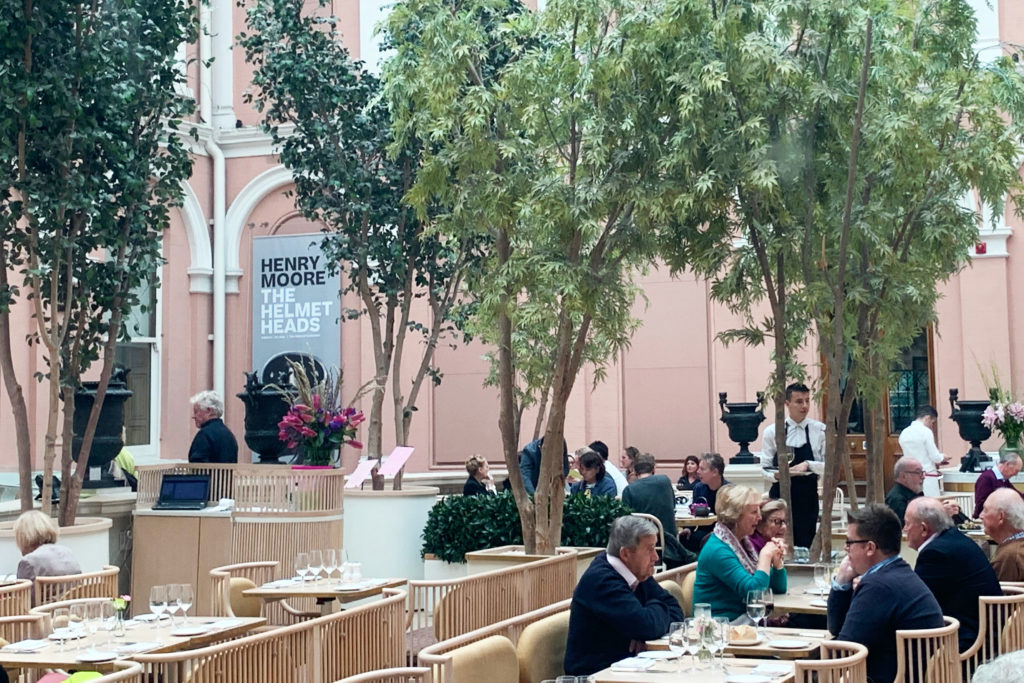
Cafe at The Wallace Collection. Photo Credit: Dandelion Chandelier.
For those in the mood for more art, though, through this courtyard and down the stairs is the special exhibition gallery, along with additional sculptures. As Yanks, we weren’t exactly sure of what to make of the forbidding bust from an unknown Italian artist, circa 1650, entitled Allegorical Portrait of America. Not really feeling the love from that one. Just sayin’.
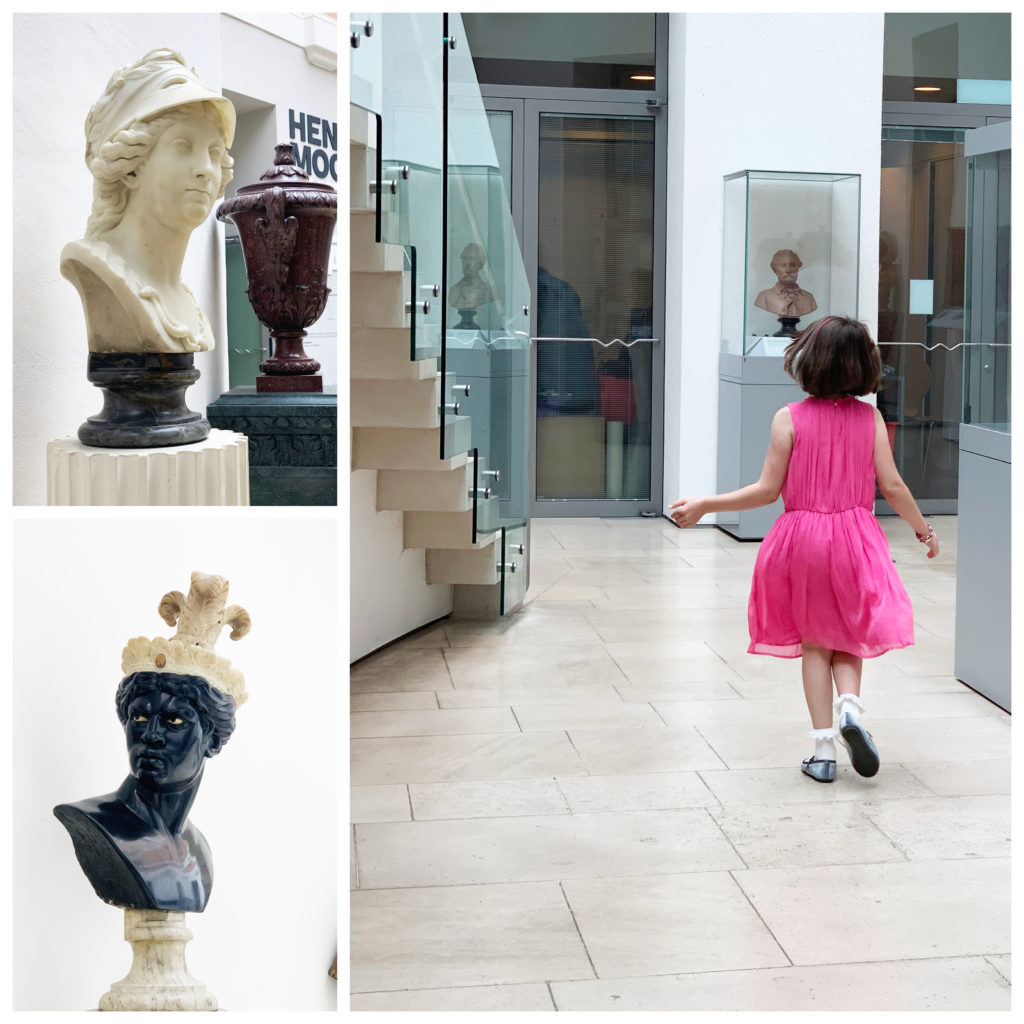
Porphyry Court at The Wallace Collection in London. Photo Credit: Dandelion Chandelier.
12. The Doors
Finally, one of the most striking elements of the entire experience of visiting The Wallace Collection is the doors. They’re ornate, and inviting. And the interior design of the house is so well-thought out that you are never far from a gorgeous vista that compels you to keep exploring.
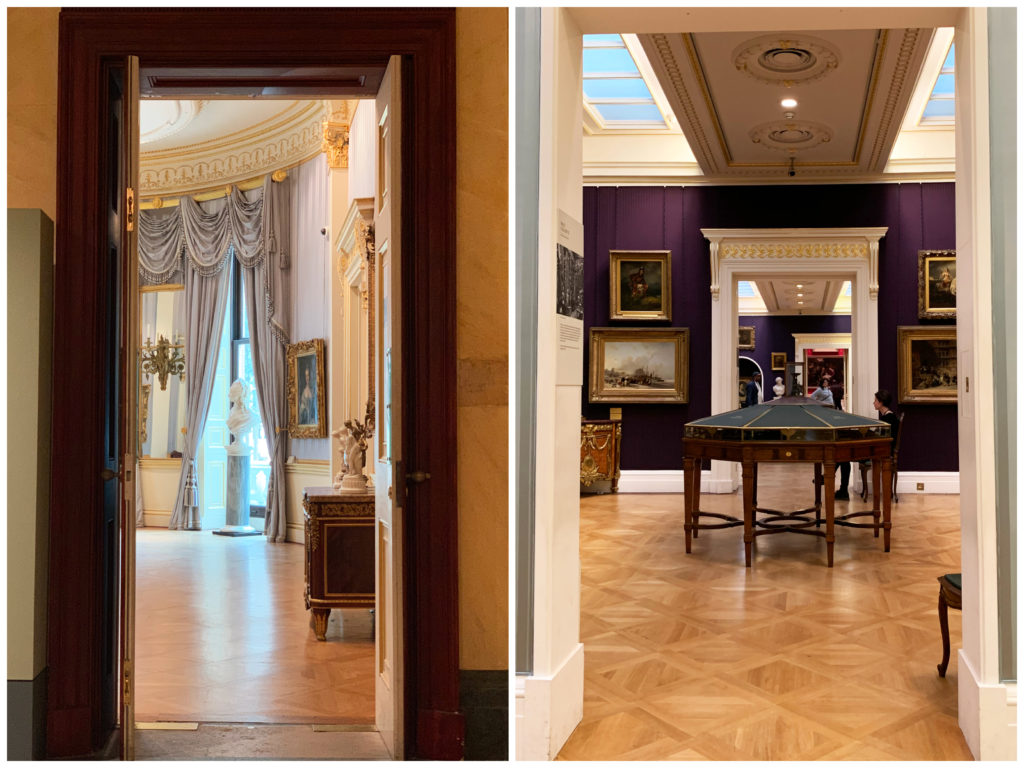
Ground floor and first floor rooms at The Wallace Collection. Photo credit: Dandelion Chandelier.
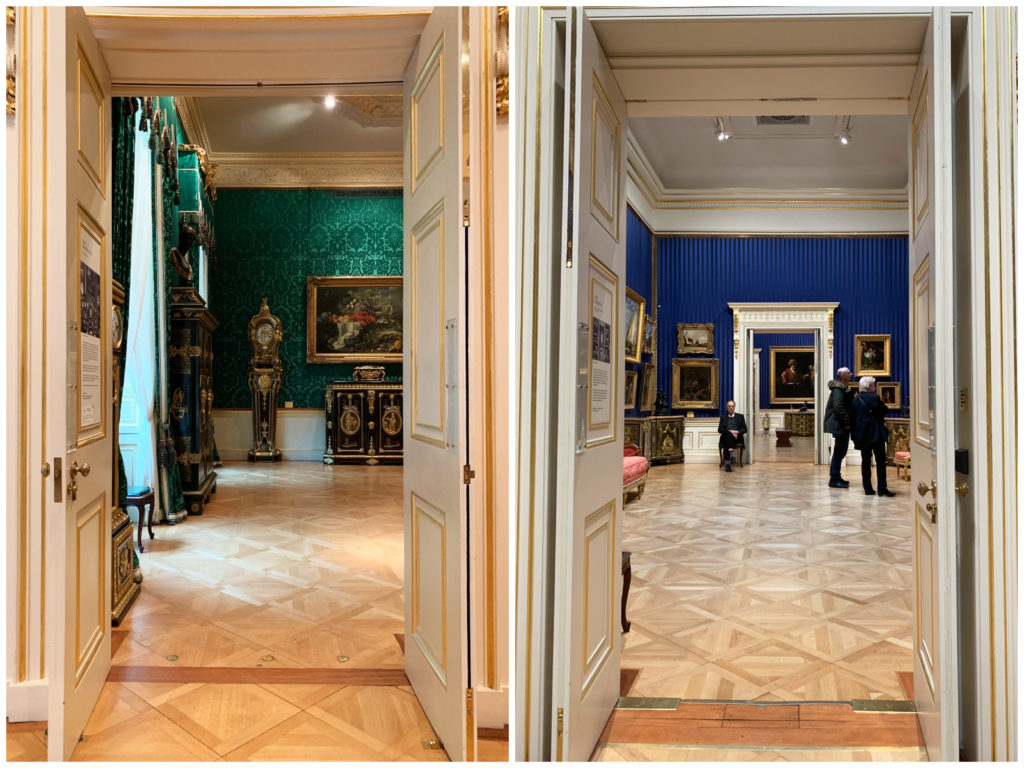
Doors to rooms on the first floor of the Wallace Collection. Photo Credit: Dandelion Chandelier.
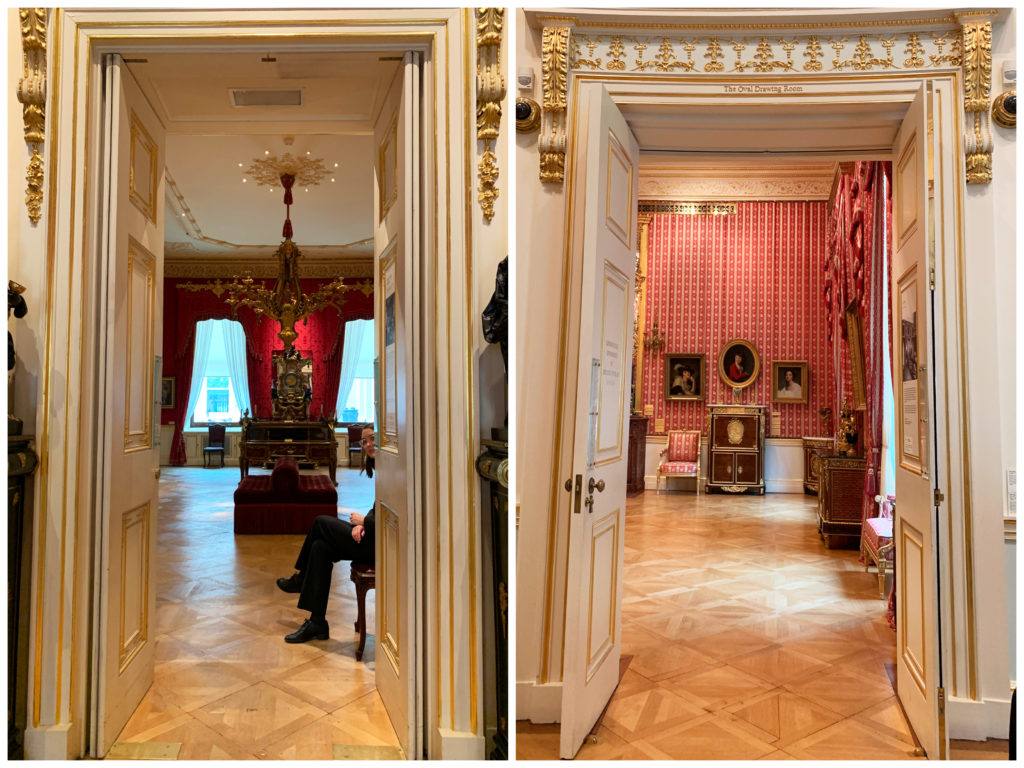
The Back State Room and the Oval Drawing Room at The Wallace Collection. Photo Credit: Dandelion Chandelier.
The doors beckon you onward: come in, come look, there’s something wonderful just over here. And the best part of all is that it’s true.
see luxury in a new light
Come and join our community! For a weekly round-up of insider ideas and information on the world of luxury, sign up for our Dandelion Chandelier Sunday Read here. And see luxury in a new light.
power up
For a weekly dose of career insights and ideas, sign up for our Sunday newsletter, Power Up, here.








